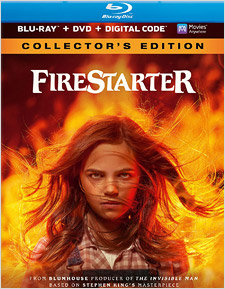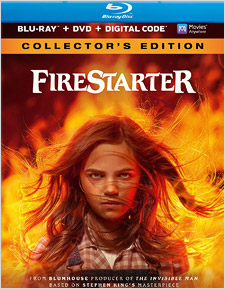Firestarter (2022) (Blu-ray Review)

Director
Keith ThomasRelease Date(s)
2022 (June 28, 2022)Studio(s)
Blumhouse Productions (Universal Pictures)- Film/Program Grade: C
- Video Grade: B
- Audio Grade: A-
- Extras Grade: B+
Review
Firestarter, based on the novel by Stephen King, was first adapted in 1984 and starred Drew Barrymore, just two years after her debut in E.T.: The Extraterrestrial. That adaptation was a reasonable translation (if not a blockbuster) of King’s novel, so it’s interesting that the green light was given for the recent remake.
Andy McGee (Zac Efron) and his wife Vicky (Sydney Lemmon) met in college as subjects in an FDA clinical trial that turned out to be a government experiment by a shadowy operation known as “The Shop” to test the effects of a mind-altering chemical compound. As a result, both Andy and Vicky have telekinetic and telepathic abilities that they’ve passed on to their daughter, 11-year-old Charlie (Ryan Keira Armstrong), who has pyrokinetic power—the ability to start fires with her mind.
Not to draw attention to their abilities, the family have kept a low profile and tried to blend in, but the parents begin to see that Charlie is having difficulty controlling her fire-starting proclivity. The agency also takes notice, and sends John Rainbird (Michael Greyeyes) to capture Charlie. As a result, Andy and Charlie go on the run.
First impressions of Firestarter are that it’s unremarkable. Young Armstrong shoulders a lot of the film and she’s really not up to it. In the original adaptation, audiences were familiar with Drew Barrymore and she elicited instant empathy. It’s harder to warm to Armstrong. Her Charlie is sweet and most effective in quiet scenes, but when she’s angry, her fierceness fails to ring true.
Efron delivers a thoughtful performance and avoids overplaying it, which keeps balance in the picture. With a beard, he looks older and his manner suggests a father torn by guilt, frustration, and fear. Unburdened with an overabundance of dialogue, he relies on facial expressions and body language to convey emotion.
The supporting characters are not developed adequately and come off merely as a means to advance the plot as quickly as possible. Gloria Reuben, as one of the people intent on bringing Charlie in for extensive study and experimentation, speaks with icily efficient authority, but is simply a vessel for loads of exposition. Lemmon’s Vicky is protective of Charlie and, when things get intense, is ready to defend her at all costs, though she has insufficient screen time. Kurtwood Smith (Dead Poets Society) plays the original administrator of the drug as a stereotypical unhinged genius who looks and acts as if he were mentored by Dr. Frankenstein. Greyeyes’ Rainbird is meant to come off as scary and cold-blooded, but never achieves the menace of, say, Anton Chigurh in No Country for Old Men.
First-time feature director Keith Thomas has the unfortunate ability to make an exciting premise lumber along, generating little suspense in the process. The visuals involving fire effects are well staged, and he succeeds in conveying the emotional and telepathic bond between father and daughter, but the overall effect of the film is rather tepid and it seems more like a made-for-TV production than a theatrical feature. Apart from updating the story to the present day, the remake remains much the same. Scott Teems’ screenplay is not particularly involving. Too much time is spent on the McGees’ efforts to be inconspicuous, too little of them on the run, and there are fewer pyrotechnic scenes than you might imagine in a picture called Firestarter. Watching the climactic scene, I was reminded of a Peggy Lee song: “Is that all there is?”
Firestarter was captured digitally by director of photography Karim Hussain in the ARRIRAW codec on CFast 2.0 cards using Arri Alexa Mini cameras and MasterBuilt Vista-M Classic, Helios, Kilfittth Macro-Kilar, and Angenieux lenses. It was then finished as a Digital Intermediate in the aspect ratio of 2.39:1. Universal’s Blu-ray presentation offers a muted color palette with desaturated hues dominating. Browns, washed out greens, mustardy yellows, greys, and blacks are used most frequently. In the McGees’ at-home scenes, there’s a yellowish cast. In one scene, lens flares are visible and momentarily take us out of the story. Uses of fire are both real and CGI-generated. A visually dramatic scene features a group of men in silver suits being blasted by a flame thrower. A fire caused by Charlie in school is both unexpected and intense, and causes a yellow/red explosion. Blood issuing from Andy’s eyes is vivid and stands out from the surrounding earth tones. Details, such as individual hairs on Charlie’s head and in Andy’s beard, and leaves on the trees in a wooded area, are nicely delineated. Charlie’s complexion is smooth and pink and Andy’s tends toward paleness.
The soundtrack is presented in English 5.1 DTS-HD Master Audio. Other options include Spanish and French 5.1 DTS Digital Surround and Descriptive Video Service. Optional subtitles include English SDH, Spanish, and French. Dialogue is clear throughout. Armstrong’s big scenes have her screaming at the top of her lungs as she directs fire toward whomever or whatever angers her. The score by John Carpenter, who was initially meant to direct the original film, is excellent. With its driving intensity and repetitive dark chords, the music often enhances scenes that lack adequate cinematic punch, yet overshadows the film itself. Sound effects include the immense swooshing of flames, pictures flying off walls and crashing against objects, and a flame thrower projecting flames.
Universal Picture’s Collector’s Edition 2-Disc Blu-ray and DVD Combo Pack also included a Digital code on a paper insert within the package. Extras include the following:
- Audio Commentary with Director Keith Thomas
- Alternate Ending (2:43)
- Deleted & Extended Scenes:
- Andy Reflects in Mirror (1:46)
- Andy’s Lot Six Nightmare – Extended (4:14)
- Wanless Gets a Visitor – Extended (2:30)
- Rainbird Scare/Wildlife Hunt (4:15)
- Charlie Treks to Find Andy (2:09)
- Charlie Counts Down “Five, Four, Three, Two, Lies” (1:07)
- Andy’s Visionary Escape from the Cell (4:11)
- Gag Reel (1:06)
- A Kinetic Energy (6:04)
- Spark a Fire (3:43)
- Igniting Firestarter (3:38)
- Power Struggle (3:28)
In the audio commentary, director Keith Thomas explains that an actual house was recreated on a sound stage and discusses the role of the production designer in creating the requisite look of the picture. Details of the sets have a role in advancing the story. He briefly discusses how different camera lenses elicit particular effects. The archived footage shown at the beginning of Firestarter is meant to show that the experiment went wrong. Thomas believes a key element in storytelling is crisis. When characters are in crisis, they come alive. It was necessary to balance the emotional content with the pyrotechnical scenes, and speaks about getting exposition across to the audience without resorting to loads of static dialogue. Storyboards were used too show what scenes should look like. He discusses his approach to dealing with actors. He doesn’t like to cut immediately after dialogue in a scene is complete, allowing the camera to linger on the actor for a few seconds. Often, things that appear to be one thing turn out to be other things. A theme of the film is that science creates what it can’t control.
Gag Reel – This segment is composed of brief moments of actors blowing lines, uncooperative props, and laughter during takes.
A Kinetic Energy – Stephen King’s novel was ripe for a remake. Ryan Kiera Armstrong was chosen from among many young actors who auditioned. Efron plays a father riddled with guilt. It was important to forge a bond between Ryan and Zac that translated to the screen. Director Keith Thomas strived to emphasize this bond in every scene.
Spark a Fire – Writer/Executive Producer Scott Teems discusses how he attempted to capture the best aspects of the novel, especially the parent/child relationship. He wanted to be “true to the emotional content of the book.” Behind-the-scenes making-of footage is included.
Igniting Firestarter – The special effects and stunt teams had to plan how to visualize the film’s big set pieces involving fire. The director wanted as much “practical fire” as possible; 99% of the effects are shot in camera. In a dangerous climactic scene, the precautions taken by the stunt men are shown, including multi-layered flame retardant attire.
Power Struggle – Director Keith Thomas aimed for realism. The stunt coordinator choreographed the fire scenes. Thomas refers to “beautiful accidents” that occur during filming that give a film its spontaneous feel.
Firestarter is about the ill-thought-out choices of parents that play out through their children, as well as the effects of government creating havoc for an ordinary family. Unfortunately, director Thomas takes a familiar path through the story, completely missing opportunities to make the picture distinctive and memorable.
- Dennis Seuling

